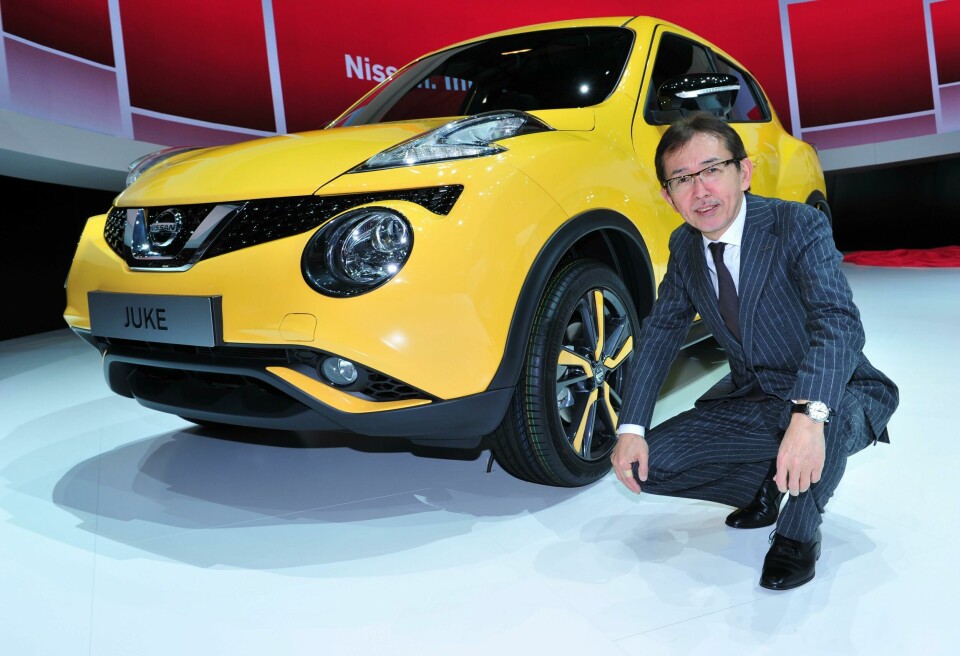
Geneva 2017: Shiro Nakamura on Nissan’s direction
Car Design News talks to Shiro Nakamura about Nissan design and why European design can look a little too serious
At the Geneva show, CDN sat down with Shiro Nakamura, chief creative officer at the Nissan Motor Company, to discuss past successes and future themes.
CDN: Nissan design has been on quite a journey over the 17 years since you joined the company. Where do you see it going next?
Actually, I think at both Infiniti and Nissan we are quite confident with the current brand direction for each one. Nissan, particularly for new generation models like Micra, has a much more clear design language, and globally are more uniform. Today I think Infiniti cars have a very strong design language. I don’t think we need to change too much, but we have to move forward. And for us electric cars are so important – we have the next Leaf and new EVs coming.
We don’t think EVs need a special identity. The current Leaf is maybe too much separated from the rest of Nissan, but when we started Leaf we didn’t have such a clear strategy. Now, we expect to have many more EV models. So that means EV becomes nothing special – just a part of the portfolio.
CDN: Would you agree that Leaf’s looks were a challenge for a car with a lot of other hurdles to overcome?That’s why we are not positioning EVs as independent from other Nissan products, so we can build a new form language for our EVs. An EV platform doesn’t really have the design advantages that people think because you need a big space for the battery, you still need intakes for cooling the batteries and inverters, so package-wise it’s not necessarily better than ICE. The constraints are different from ICE cars.
We are working on a new range of EVs now. We will have a new Leaf quite soon, followed by other EVs. Even at this show, we have made it clear we are committed to EVs and autonomous drive. We are working quite strategically and very aggressively for future EVs.
CDN: Many mainstream brands are adopting premium design cues. Does the presence of Infiniti limit the directions in which Nissan’s design language can evolve?
There is no internal conflict between our two brands. Infiniti is organically emotional, and Nissan is modern and geometrically emotional. So we express emotions by different routes. Of course elements like pillar shapes are different, but those are just elements. The overall feeling is organic versus geometrical.
Also proportion-wise, we have more front-wheel drive for Nissan. Except for GT-R and Z, because sports cars are different, it’s all front-wheel drive. Infiniti has rear wheel drive so proportions are different, form language is different, design cues – grille shapes, pillars – those are all different. So it’s quite clear how we separate the two.
CDN: The latest Micra has adopted a very aggressive, dynamic look while key rivals like the new Fiesta and Rio have gone in the other direction. Is Nissan out of step?
We don’t want to have a conservative form language. We don’t intend to move towards German companies, we want to be a uniquely Japanese brand.
CDN: Juke has been a great success with a very brave, polarising design. Presumably, you’d like to create more vehicles that take big risks but might bring big rewards?
Yes, we want to continue. But Juke was only possible because we had Qashqai, which is made in much bigger volume for mainstream hatchback customers. Juke is slightly smaller and for people looking for something more unique and expressive.

But Qashqai was also brave. We had never been successful with C-segment hatchbacks so we had to do something different.
CDN: The arrowhead form BladeGlider is pretty unique too. You’ve gone to the trouble of designing a second version, so where is that project going?
The first one at the Tokyo show was a concept, the one we have here today is a real car you can drive. Design-wise it’s not easy. With the narrow front and wide rear, it’s very challenging to make the car look balanced. Particularly as we have had to go up in height; the Tokyo concept was much lower.


It’s not a 1+2; this is a full three-seater. Three adults can sit in it, actually quite comfortably. The roominess is much more than the original but making the balance is a real challenge.

It’s been a fun project and I’d like to see them made in a small run. I don’t think they would sell in big numbers because it’s a small niche. But there are all sorts of regulations in the way.
CDN: What do you think is noteworthy about the Qashqai facelift revealed here in Geneva?
We wanted to make it more clearly a Nissan, but Qashqai cannot be radical, because today’s car is very popular. The second generation was much more emotional and aggressive, but we have to handle it carefully, like a Golf. It’s the crossover Golf.
Your partners in the Renault-Nissan Alliance have put 20-inch wheels on the Scénic. Could we see 20-inch wheels as standard on a future Qashqai?
I think that looks very French. They have a history of big diameter wheels – it’s very natural. But I don’t think that’s a fit for us.
What might be the equivalent Japanese design feature?
That’s not so easy to say. There are fewer iconic Japanese cars. In France, they have the 2CV, the DS, a long history of iconic cars. In our case, I don’t think we have so many. But Juke is very Japanese. No other company could have produced Juke. It’s brave, funny, not serious, approachable, smiling – it has the face of an anime character. European design, I think, has become very serious.



